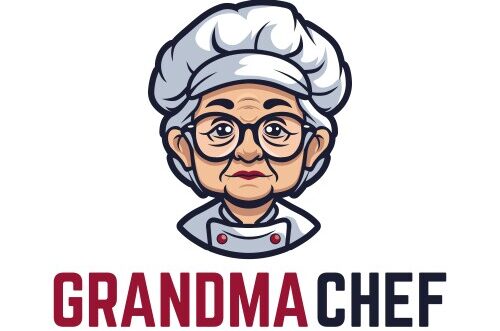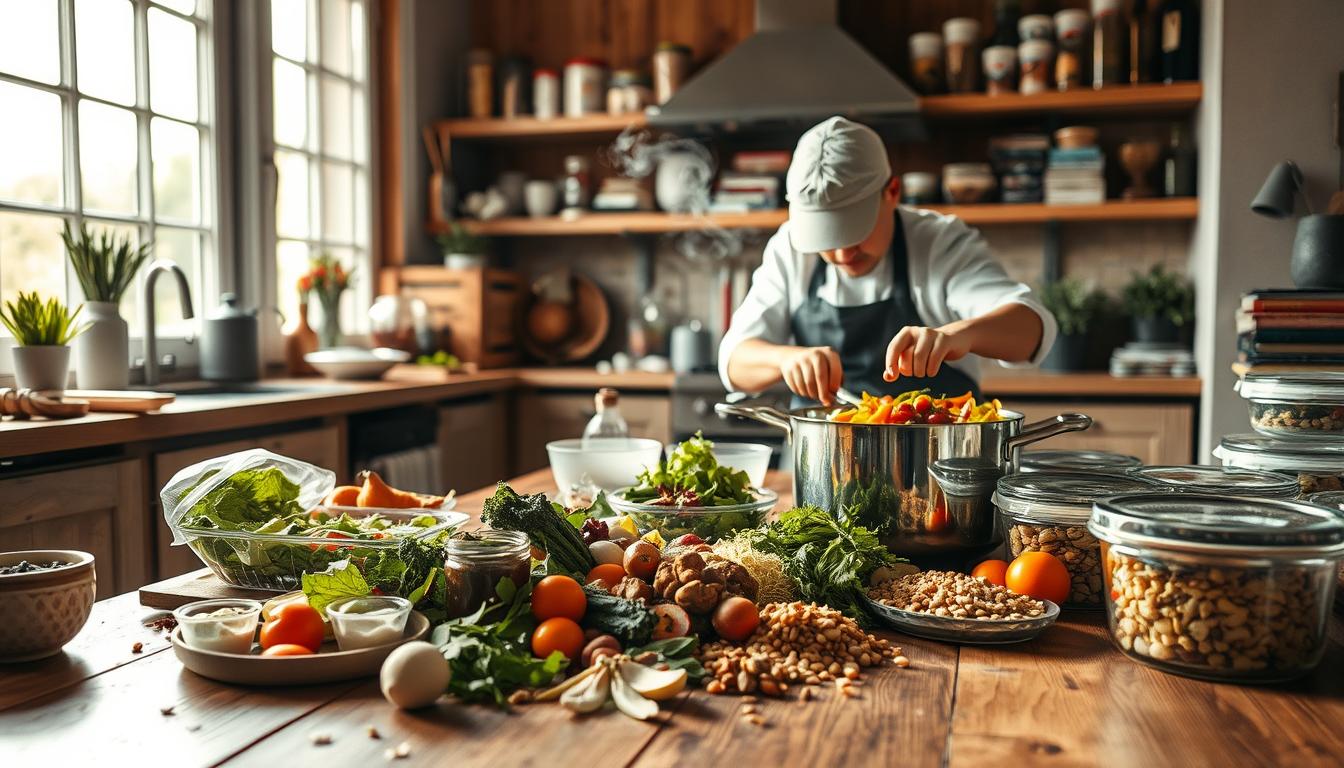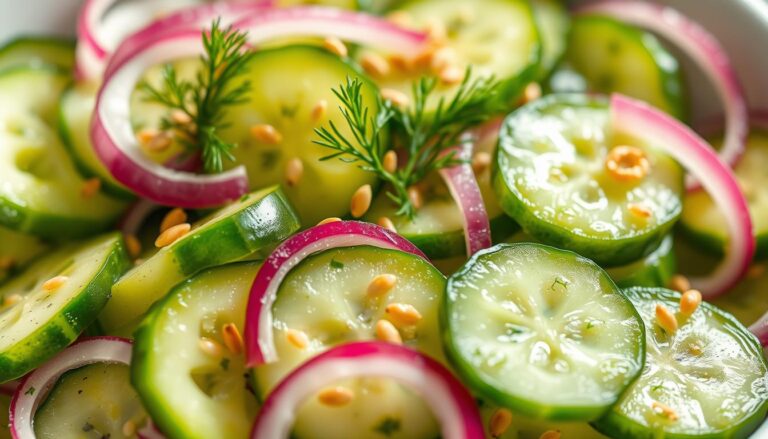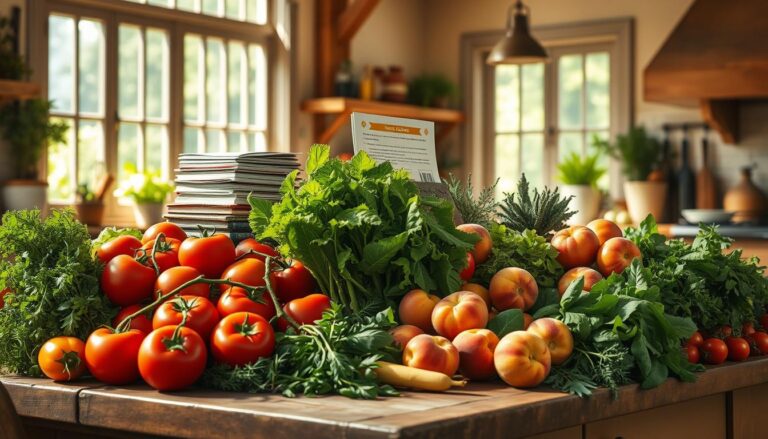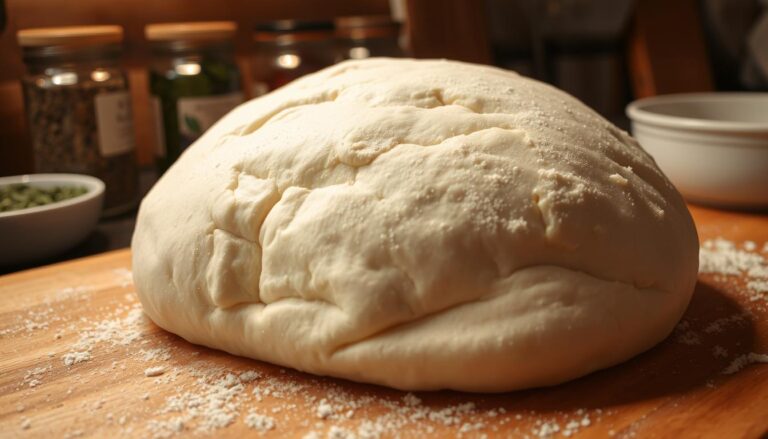Cooking Leftovers: Transform Leftovers into Delicious Meals
In a world where food waste is a growing concern, creative leftover cooking has become more than just a necessity – it’s an art form. “Cuisine de restes,” or the art of cooking with leftovers, is a simple yet effective way to reduce waste and create delicious meals.
By adopting a “Cuisine de restes” approach, home cooks can not only reduce their environmental footprint but also explore new flavors and recipes. This article will guide you through the basics of leftover cooking, providing tips and tricks for transforming yesterday’s dinner into tomorrow’s culinary masterpiece.
Key Takeaways
- Discover the benefits of sustainable cooking with leftovers.
- Learn simple techniques for transforming leftovers into new meals.
- Explore creative recipes that reduce food waste.
- Understand the environmental impact of food waste and how to mitigate it.
- Get tips on planning meals around leftovers for a more sustainable kitchen.
Understanding Cuisine de restes: The Art of Leftover Cooking
Embracing the philosophy of Cuisine de restes means adopting a sustainable approach to cooking that minimizes waste and maximizes flavor. This French culinary tradition is built on the principle of transforming leftovers into delicious meals, showcasing creativity and resourcefulness in the kitchen.
The French Philosophy Behind Waste-Free Cooking
The concept of Cuisine de restes is deeply rooted in French cuisine, where cooking is not just about following recipes but about creating meals that are both nourishing and environmentally conscious. It’s a philosophy that encourages cooks to think creatively about leftovers, turning what might otherwise be discarded into something new and exciting.
Historical Context of Cooking with Leftovers
Cooking with leftovers has a long history that predates modern French cuisine. In the past, households had to be resourceful with the ingredients they had available, making the most of every meal. This practice not only reduced waste but also showcased the cook’s ability to be innovative with limited resources. Today, this historical context informs the way we approach leftover cooking, making it a valuable skill in contemporary kitchens.
By understanding and embracing Cuisine de restes, home cooks can contribute to a more sustainable cooking culture, one that values creativity and minimizes waste.
Why Repurposing Leftovers Matters
Repurposing leftovers is not just about reducing waste; it’s a culinary art that benefits our planet, wallet, and health. By adopting this practice, individuals can make a significant impact on various aspects of their lives and the environment.
Environmental Impact of Food Waste
Food waste is a significant environmental issue, with the average American household throwing away approximately 40% of the food they purchase. Reducing food waste through leftover cooking can help minimize the environmental impact of food production, processing, and disposal. This includes lowering greenhouse gas emissions and conserving water and land resources.
Economic Benefits of Using Everything
Cooking with leftovers can also have substantial economic benefits. By planning meals and using all the ingredients purchased, households can save money on food expenses. Reducing food waste is a cost-effective way to stretch the family budget, as it ensures that every dollar spent on groceries counts towards a meal.
Nutritional Advantages of Planned Leftovers
Planned leftover cooking can contribute to a more balanced diet. By creatively repurposing leftovers, individuals can ensure a varied intake of nutrients. Nutritional advantages come from being able to consume a wide range of foods, including vegetables, proteins, and whole grains, even on busy days when cooking from scratch isn’t feasible.
Overall, repurposing leftovers is a simple, effective strategy for enhancing sustainability, saving money, and maintaining nutritional balance.
Essential Principles of Transforming Leftovers
Transforming leftovers into new meals is an art that requires creativity and a few essential principles. At its core, successful leftover cooking involves more than just reheating last night’s dinner; it’s about understanding how to reimagine and reinvent meals.
Thinking Beyond Reheating
The first step in transforming leftovers is to move beyond simple reheating. This means considering the ingredients you have on hand and thinking about how they can be repurposed into a new dish. For example, last night’s roasted chicken can become tomorrow’s chicken salad or chicken soup.
Understanding Flavor Development
Flavor development is crucial when transforming leftovers. It’s about enhancing and layering flavors to create a dish that’s more than the sum of its parts. This can involve adding herbs, spices, or other seasonings to elevate the dish.
The Rule of Three: New Texture, Flavor, or Form
A useful guideline in leftover cooking is the “Rule of Three,” which suggests changing at least one of three elements: texture, flavor, or form. For instance, turning last night’s mashed potatoes into crispy potato cakes changes both texture and form, making the dish feel fresh and new.
| Original Dish | Transformation | Change |
|---|---|---|
| Mashed Potatoes | Potato Cakes | Texture, Form |
| Roasted Chicken | Chicken Salad | Texture, Form |
| Beef Stew | Beef Sandwich Filling | Form |
Smart Storage: Setting Yourself Up for Success
Transforming leftovers into culinary masterpieces starts with proper food storage. Effective storage is the backbone of successful Cuisine de restes, ensuring that your leftovers remain fresh and ready for their next culinary act.
Container Systems That Work
Investing in a good container system is crucial. Look for containers that are airtight, durable, and versatile. Glass containers are excellent as they are non-reactive and can be used for both storage and reheating. “A good container can make all the difference in keeping your leftovers fresh,” says a culinary expert.
Labeling and Organization Strategies
Labeling your containers is essential for keeping track of what you have stored and how long it’s been stored. Use a marker to write the date and contents on the container. Organizing your fridge and freezer into sections can also help in quickly identifying leftovers.
Freezing Techniques for Maximum Quality
Freezing is a great way to extend the life of your leftovers. To maintain quality, portion your leftovers into usable sizes before freezing. Use airtight containers or freezer bags to prevent freezer burn. Flash freezing individual portions can also be effective for meals like soups or casseroles.
Transforming Leftover Proteins
Leftover proteins can be the foundation for a variety of creative and delicious dishes. Whether you’re working with chicken, beef, pork, fish, seafood, or plant-based proteins, there are countless ways to transform them into new meals.
Chicken Transformations: Salads, Tacos, and Pot Pies
Chicken is a versatile protein that can be easily transformed into various dishes. Try shredding leftover chicken and adding it to a salad with your favorite greens and dressing, or use it as a filling in tacos with salsa and avocado. You can also mix chicken with vegetables and creamy sauce, then bake it in a pot pie crust.
Beef and Pork Reinventions: Sandwiches, Hash, and Stir-Fries
Leftover beef and pork can be repurposed into hearty sandwiches, hash, or quick stir-fries. Slice the meat thinly and serve on a bun with your favorite toppings, or chop it into small pieces and mix with diced potatoes and onions for a satisfying hash. Stir-fries are also a great option, combining the protein with a variety of vegetables and sauces.
Fish and Seafood Second Acts: Cakes, Chowders, and Spreads
Fish and seafood leftovers can be turned into delicious cakes, chowders, or spreads. Flake the fish and mix it with breadcrumbs, egg, and seasonings, then shape into patties and pan-fry until crispy. Alternatively, simmer the seafood in a flavorful broth with vegetables to create a comforting chowder, or blend it into a creamy spread for crackers or bread.
Plant-Based Protein Makeovers: Bowls, Burgers, and Stuffed Vegetables
Plant-based proteins like beans, lentils, or tofu can be transformed into nourishing bowls, burgers, or fillings for stuffed vegetables. Mix cooked beans or lentils with your favorite spices and herbs, then serve over rice or quinoa. You can also shape tofu or bean mixtures into patties for burgers, or fill bell peppers with a mixture of rice, beans, and vegetables.
| Protein | Transformation Ideas |
|---|---|
| Chicken | Salads, Tacos, Pot Pies |
| Beef/Pork | Sandwiches, Hash, Stir-Fries |
| Fish/Seafood | Cakes, Chowders, Spreads |
| Plant-Based | Bowls, Burgers, Stuffed Vegetables |
New Life for Leftover Grains and Starches
Breathing new life into leftover grains and starches is easier than you think, and it’s a great way to reduce food waste. With a bit of creativity, you can transform yesterday’s staples into today’s exciting meals.
Leftover grains and starches, such as rice, pasta, potatoes, and bread, are versatile ingredients that can be repurposed in numerous ways. The key is to think beyond their original form and explore new textures, flavors, and dishes.
Rice Dishes Reimagined: Fried Rice, Arancini, and Pudding
Leftover rice is a blank canvas waiting for your culinary creativity. You can turn it into fried rice with vegetables and your choice of protein, or shape it into arancini (Italian rice balls) filled with mozzarella and tomato sauce. For a sweet treat, consider making a rice pudding flavored with cinnamon and raisins.
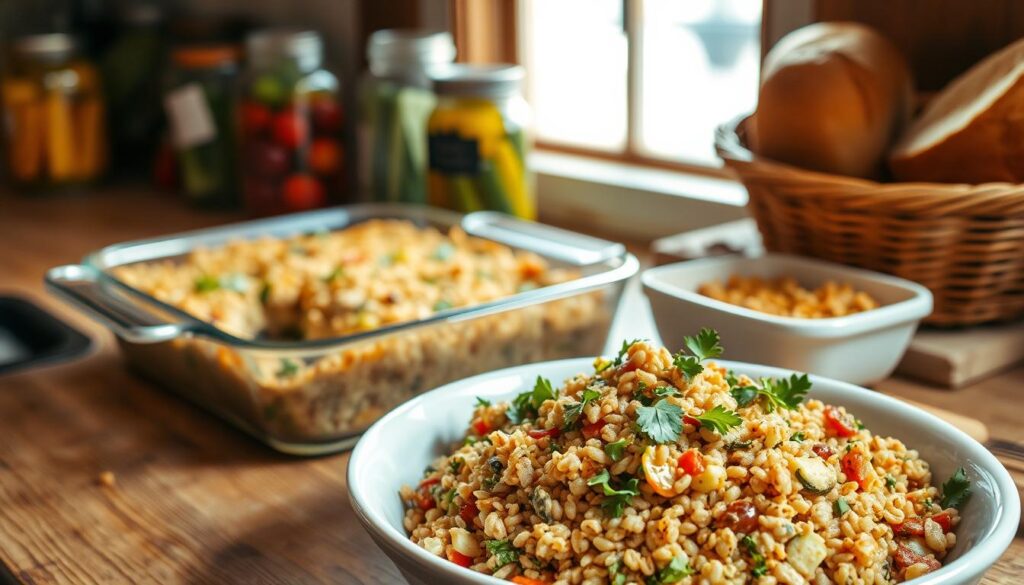
Pasta Transformations: Frittatas, Bakes, and Salads
Pasta leftovers can be easily transformed into a frittata by mixing it with eggs, vegetables, and cheese, then baking until set. Alternatively, you can create a pasta bake with a rich tomato sauce and melted mozzarella on top. For a lighter option, toss pasta with fresh vegetables and a homemade vinaigrette to make a refreshing salad.
Potato and Bread Revivals: Croquettes, Croutons, and Breakfast Hashes
Leftover potatoes can be mashed and shaped into croquettes, which are then fried until crispy. Bread leftovers can be cubed and toasted into croutons for salads or soups. You can also dice bread and potatoes to make a hearty breakfast hash with eggs and your favorite breakfast meats.
| Leftover Ingredient | New Dish | Description |
|---|---|---|
| Rice | Fried Rice | A Chinese-inspired dish made with leftover rice, vegetables, and your choice of protein. |
| Pasta | Pasta Frittata | A Italian-style omelette filled with pasta, eggs, and cheese. |
| Potatoes | Potato Croquettes | Crispy fried balls made from mashed potatoes and often filled with ham or cheese. |
Cuisine de restes Techniques for Vegetables
The art of repurposing vegetables is a cornerstone of Cuisine de restes, offering a world of flavors and textures to explore. By applying a few simple techniques, you can transform leftover vegetables into entirely new dishes.
Roasted Vegetable Transformations
Roasted vegetables can be repurposed in various ways. Consider turning them into:
- Purees: Blend roasted vegetables into soups or dips.
- Tarts: Use roasted vegetables as fillings in savory tarts.
- Grain Bowls: Top a bed of grains with roasted vegetables, adding protein and a flavorful sauce.
Salad Leftovers Reimagined
Don’t let leftover salads go to waste. Transform them into:
- Wraps: Use salad as a filling in wraps or sandwiches.
- Soups: Blend salad leftovers with broth for a quick and easy soup.
- Dips: Mix salad with cream cheese or yogurt for a tasty dip.
These ideas not only reduce waste but also create new, exciting meals.
Using Vegetable Scraps Creatively
Vegetable scraps can be used to make:
- Stocks: Simmer scraps in water to create a flavorful stock.
- Pickles: Slice scraps thin and pickle them for a tangy snack.
- Garnishes: Use raw or cooked scraps as garnishes for soups, salads, or main dishes.
By getting creative with vegetable scraps, you can significantly reduce waste and add depth to your cooking.
One-Dish Wonders: Complete Meals from Mixed Leftovers
Cuisine de restes reaches its peak with one-dish wonders, where leftovers are transformed into satisfying meals. This approach to cooking not only reduces food waste but also offers a canvas for creativity in the kitchen.
Frittatas and Omelets: The Ultimate Leftover Vehicle
Frittatas and omelets are versatile dishes that can incorporate a variety of leftovers, from vegetables and meats to grains and cheeses. They are perfect for breakfast, lunch, or dinner, offering a quick and easy meal solution.
Soups and Stews: Layering Flavors with Leftovers
Soups and stews are excellent ways to combine different leftovers, creating rich and flavorful dishes. By layering ingredients and flavors, you can craft meals that are both nourishing and comforting.
Casseroles and Bakes: Comfort Food from Yesterday’s Meals
Casseroles and bakes are quintessential comfort foods that can be made using a mix of leftovers. These dishes are not only satisfying but also easy to prepare, making them ideal for weeknight meals or special occasions.
By embracing one-dish wonders, home cooks can enjoy the benefits of leftover cooking while exploring new culinary possibilities. Whether it’s a frittata, soup, stew, casserole, or bake, these meals offer a delicious way to reduce waste and delight the palate.
Planning for Intentional Leftovers
Intentional leftovers are the backbone of a sustainable kitchen. By planning meals that generate useful leftovers, home cooks can significantly reduce food waste and create a more efficient cooking routine.
Cook-Once-Eat-Twice Strategies
A key approach to intentional leftovers is the “cook-once-eat-twice” strategy. This involves preparing a larger quantity of food than needed for one meal, with the excess serving as the foundation for a future meal. For example, roasting a whole chicken can provide enough meat for two dinners: a roast chicken dinner and a chicken salad or soup the following night.
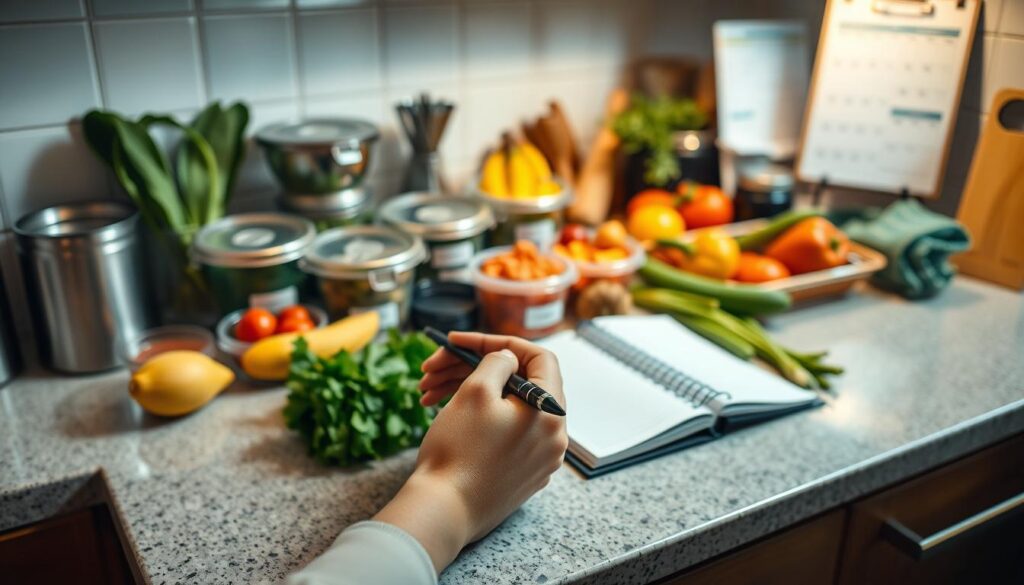
Ingredient Prep for Multiple Meals
Another effective strategy is preparing ingredients that can be used across multiple meals. This might involve chopping a large batch of vegetables that can be used in various dishes throughout the week, such as stir-fries, salads, and soups.
Building a Weekly Menu with Leftovers in Mind
When planning a weekly menu, consider how each meal’s leftovers can be repurposed. Designing a menu around a central ingredient that can be transformed in various ways can simplify meal planning and reduce waste. For instance, a roast beef dinner can be followed by beef sandwiches, beef stew, or a beef and vegetable stir-fry.
By adopting these strategies, home cooks can make leftover cooking a seamless part of their culinary routine, reducing waste and enhancing creativity in the kitchen.
Common Mistakes to Avoid in Leftover Cooking
To truly master the cuisine de restes, one must be aware of the common mistakes that can ruin a dish. Cooking with leftovers requires attention to detail, creativity, and a understanding of how to avoid pitfalls.
Safety Concerns and Food Storage Errors
One of the most critical aspects of leftover cooking is ensuring food safety. This involves proper storage techniques, such as using airtight containers and labeling leftovers with dates. It’s also crucial to store food at the correct temperature to prevent bacterial growth.
Texture and Flavor Pitfalls
Avoiding texture and flavor pitfalls is essential for creating enjoyable leftover dishes. This can be achieved by varying cooking techniques and adding fresh ingredients to revitalize the dish. For instance, adding a squeeze of fresh lemon juice or a sprinkle of herbs can greatly enhance flavor.
Overcoming Leftover Fatigue
Leftover fatigue can be overcome by introducing new cooking tips and techniques into your routine. This might involve exploring different cuisines for inspiration or experimenting with novel ingredient combinations to keep meals interesting.
By being mindful of these common mistakes and taking steps to avoid them, individuals can elevate their leftover cooking skills and enjoy a more varied and sustainable culinary experience.
Global Inspirations for Leftover Cooking
From Asia to Latin America, cultures worldwide have mastered the art of repurposing leftovers. This global approach to leftover cooking not only reduces food waste but also showcases the creativity and resourcefulness of various culinary traditions.
Asian Approaches: Fried Rice, Congee, and Noodle Dishes
Asian cuisines are renowned for their innovative leftover cooking techniques. Fried rice is a staple dish in many Asian cultures, made by transforming leftover rice into a flavorful meal with vegetables, meats, and spices. Congee, a rice porridge, is another comforting dish that can be made with leftover rice and various ingredients. Noodle dishes, such as Pad Thai, also often utilize leftover vegetables and proteins.
- Fried rice with various toppings
- Congee with preserved eggs and ginger
- Noodle stir-fries with leftover vegetables
Mediterranean Traditions: Panzanella, Frittata, and Mezze Plates
Mediterranean cuisines offer their own unique takes on leftover cooking. Panzanella, an Italian bread salad, is a delicious way to use stale bread, tomatoes, and mozzarella. A frittata is a versatile Italian omelette that can incorporate a variety of leftovers, from vegetables to meats. Mezze plates, common in Greek and Middle Eastern cuisine, often feature an array of small dishes made from leftover ingredients, such as hummus, tabbouleh, and grilled meats.
- Panzanella with fresh basil
- Frittata with roasted vegetables
- Mezze plates with assorted dips and spreads
Latin American Classics: Chilaquiles, Empanadas, and Rice Dishes
Latin American cuisines are rich in leftover cooking traditions. Chilaquiles, a Mexican dish, transforms leftover tortillas into a spicy, savory meal with salsa, cheese, and sour cream. Empanadas can be filled with leftover meats, cheeses, or vegetables, making them a versatile leftover cooking option. Rice dishes, such as Arroz con Pollo, often utilize leftover chicken, rice, and vegetables.
- Chilaquiles with fried eggs and cheese
- Empanadas with various fillings
- Rice dishes with grilled meats and vegetables
Conclusion: Embracing the Cuisine de restes Mindset
Adopting the Cuisine de restes philosophy is a journey towards sustainable cooking and a more mindful approach to food. By transforming leftovers into delicious meals, we not only reduce food waste but also cultivate a creative and resourceful cooking philosophy.
The benefits of Cuisine de restes extend beyond the kitchen, contributing to a more sustainable lifestyle and a deeper appreciation for the food we eat. As we’ve explored, this approach to cooking offers numerous environmental, economic, and nutritional advantages.
By incorporating the techniques and principles outlined in this article, home cooks can unlock the full potential of leftover cooking. Embracing Cuisine de restes is about more than just reducing waste; it’s about embracing a cooking philosophy that values creativity, sustainability, and the joy of cooking.
